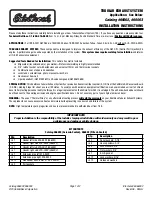
176
STARTING AND OPERATING
Before Climbing A Steep Hill – As you approach
a hill consider its grade or steepness. Determine
if it is too steep. Look to see what the traction is
on the hill side trail. Is the trail straight up and
down? What is on top and the other side? Are
there ruts, rocks, branches or other obstacles
on the path? Can you safely recover the vehicle
if something goes wrong? If everything looks
good and you feel confident, then change trans
-
mission into a lower gear, shift the transfer case
into 4WD LOW and proceed with caution. You
should use first gear and 4WD LOW for very
steep hills.
Driving Uphill – Once you have determined your
ability to proceed and have shifted into the
appropriate gear, line your vehicle up for the
straightest possible run. Accelerate with an easy
constant throttle and apply more power as you
start up the hill. Do not race forward into a steep
grade, the abrupt change of grade could cause
you to lose control. If the front end begins to
bounce, ease off the throttle slightly to bring all
four tires back on the ground. As you approach
the crest of the hill ease off the throttle and
slowly proceed over the top. If the wheels start
to slip as you approach the crest of a hill, ease
off the accelerator and maintain headway by
turning the steering wheel no more than a
quarter turn quickly back and forth. This will
provide a fresh "bite" into the surface and will
usually provide enough traction to complete the
climb. If you do not make it to the top, place the
vehicle in REVERSE and back straight down the
grade using engine resistance along with the
vehicle brakes.
Driving Downhill – Before driving down a steep
hill you need to determine if it is too steep for a
safe descent. What is the surface traction? Is
the grade too steep to maintain a slow
controlled descent? Are there obstacles? Is it a
straight descent? Is there plenty of distance at
the base of the hill to regain control if the vehicle
descends too fast? If you feel confident in your
ability to proceed then make sure you are in
4WD LOW with the transmission in FIRST gear
(manually select FIRST gear on automatic trans
-
missions) and proceed with caution. Allow
engine braking to control the descent and apply
your brakes if necessary, but do not allow the
tires to lock.
Driving Across An Incline – If at all possible
avoid driving across an incline. If it is necessary,
know your vehicle's abilities. Driving across an
incline places more weight on the downhill
wheels, which increases the possibilities of a
downhill slide or rollover. Make sure the surface
has good traction with firm and stable soils. If
possible transverse the incline at an angle
heading slightly up or down.
WARNING!
Never attempt to climb a hill at an angle or turn
around on a steep grade. Driving across an
incline increases the risk of a roll over, which
may result in severe injury or death.
WARNING!
Do not descend a steep grade in NEUTRAL. Use
vehicle brakes in conjunction with engine
braking. Descending a grade too fast could
cause you to lose control and be seriously
injured or killed.
WARNING!
Driving across an incline increases the risk of a
rollover, which may result in severe injury.
22_DJD2_OM_EN_USC_t.book Page 176
Summary of Contents for RAM 2500 2022
Page 1: ...2022 RAM 2500 3500 OWNER S MANUAL...
Page 10: ...2022 RAM 2500 3500 OWNER S MANUAL...
Page 492: ......















































